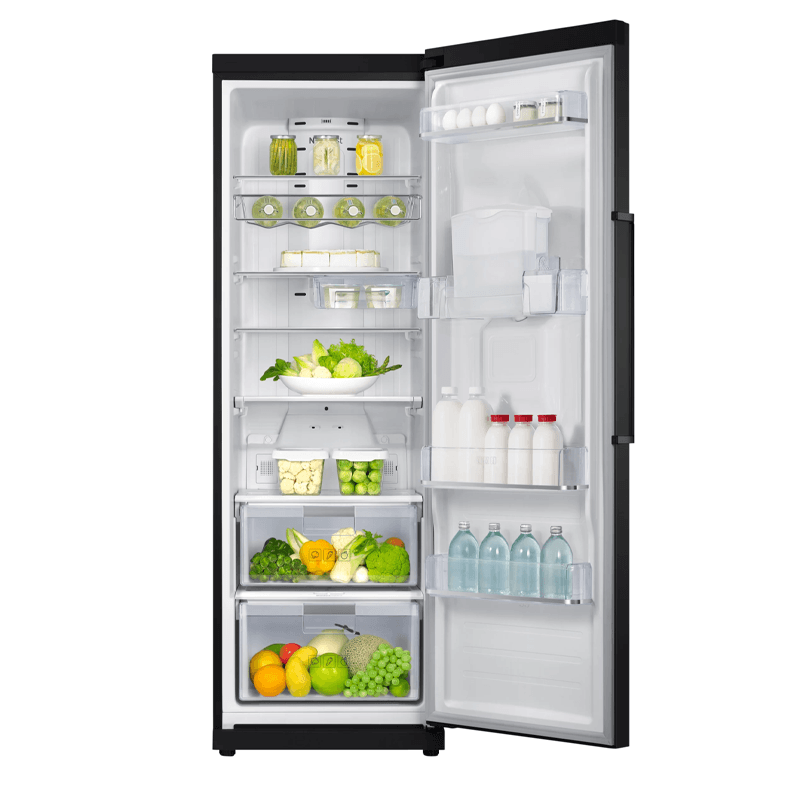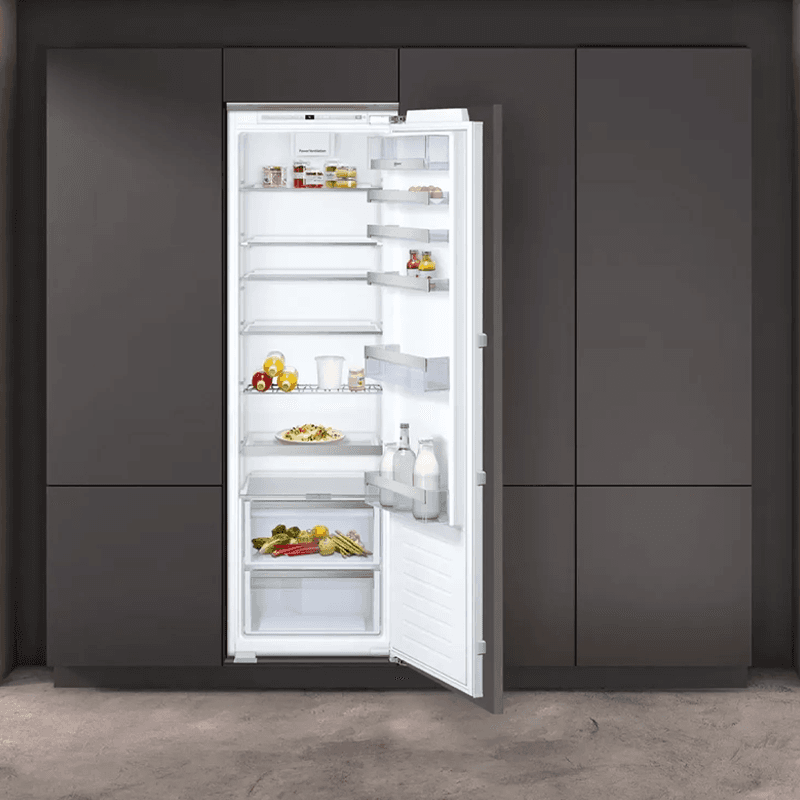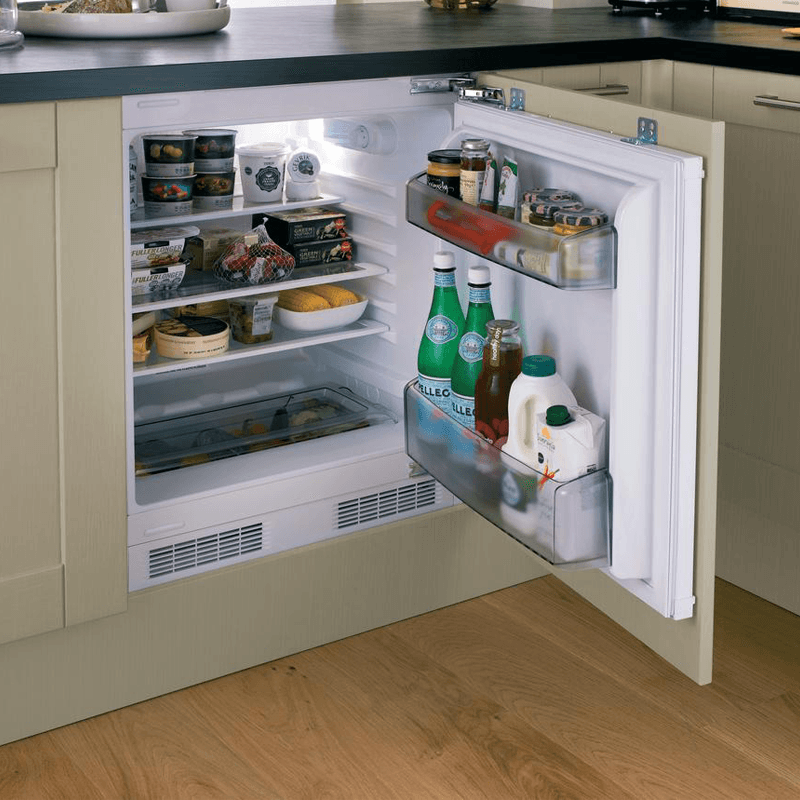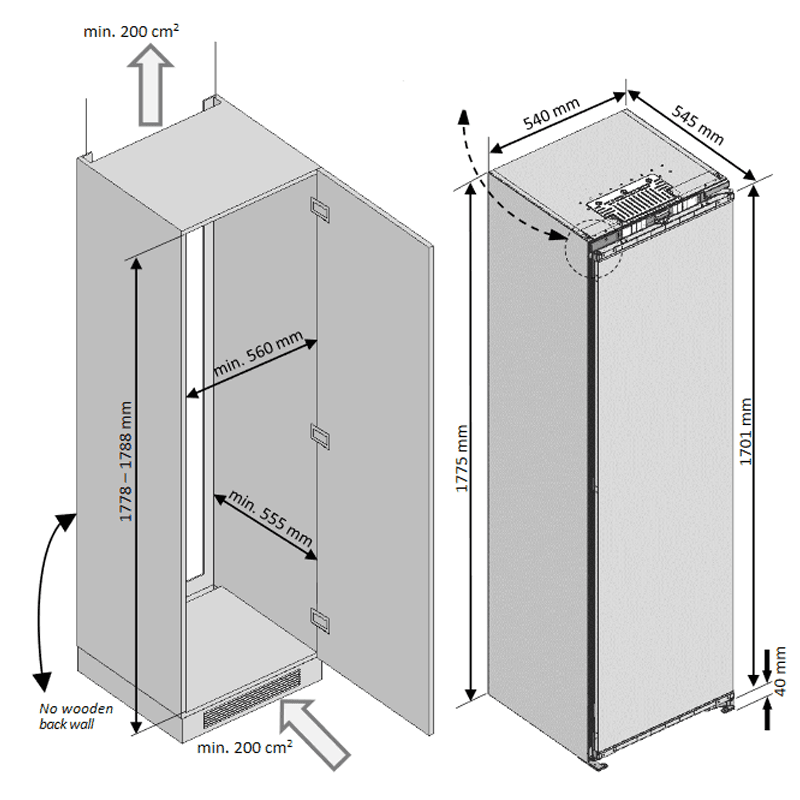Refrigerator Buying Guide
Refrigeration Buying Guide: Your Comprehensive Guide to Upgrading Your Refrigerator
Are you considering an upgrade for your refrigerator? Delve into our expert guide, tailored to walk you through the myriad of choices, including types, sizes, and features, ensuring your selection aligns perfectly with your needs and preferences. Let's delve deeper into each aspect
Selecting Your Perfect Fit: Freestanding or Fully Integrated?
The initial step is to determine your preferred fit: freestanding or integrated. Considerations span from spatial requirements to aesthetic harmony within your kitchen layout.

Freestanding Fridge
Embark on the timeless journey with a freestanding fridge, offering unparalleled flexibility in size and design. These upright marvels showcase your culinary prowess without hiding behind panels. Plus, they grant you the freedom to relocate effortlessly.

Integrated Fridge
For those seeking a seamless, clutter-free kitchen aesthetic, integrated fridges are the epitome of discreet elegance. Nestled behind cupboard doors, they merge seamlessly with your cabinetry, amplifying the illusion of space.
Fridge Types & Sizes: Exploring Fridge Varieties
Once you've determined the fit, it's time to explore the diverse array of fridge types, catering to your unique requirements.
Freestanding Fridge Types

Full Length Fridges
These units are full size fridges. Ideal if you have a larger family and a large space for it to occupy.

Undercounter Fridges
These units seamlessly fit under your counter to save space. They're smaller capacity makes them ideal for 1-2 people households and apartments.

Compact Fridges
Compact fridges or mini fridges can be a great solution for a small space to cool beverages or small amounts of food.
Integrated Fridge Types

Built-in Fridge
Camouflage your fridge behind cabinetry for a seamless look in any kitchen.

Built-under Fridge
Seamlessly blend your fridge under your countertop, ideal for smaller spaces.
Measuring for a New Fridge: Understanding Fridge Dimensions

Size matters! Each fridge type boasts a spectrum of dimensions. Factor in household size, storage needs, and available space when making your selection.
Freestanding Fridge Sizes
From lofty uprights offering expansive storage to sleek under-counter solutions, and compact wonders perfect for cozy abodes, there's a size tailored to every kitchen. The standard size for a tall fridge is 1780mm but these can go up to 1980mm and down as far as 800mm for undercounter options. Be sure to check your fridges dimesions before purchasing as even the pictures can sometimes make them appear larger or smaller than they are. This information should be available in the product description section.
Integrated Fridge Sizes
Integrated fridges maintain uniform dimensions, ensuring a snug fit within standard cabinetry setups. There are a couple of different variations as you can get standard and extra height options. Be sure to check your measuements first just incase the fridge you want is slighty different than standard.
Under Counter Fridge Sizes
Undercounter fridges are typically 800mm-850mm tall and can vary in width. Compact or table top fridges can vary in both height and width so make sure to double check the product description for exact sizes.
Fridge Energy Ratings: Prioritizing Efficiency
Make an environmentally conscious choice by opting for energy-efficient models boasting superior ratings, reducing both your carbon footprint and utility bills.

Features to Consider: Elevating Utility

Water Dispenser
Indulge in filtered, chilled water at your fingertips, with the added convenience of non-plumbed options offering flexibility in placement.
Smart Technology
Harness the power of Wi-Fi connectivity, empowering you to monitor and control your fridge remotely, ensuring optimal freshness and organization
Auto Defrost
Bid farewell to manual defrosting woes! Opt for auto defrost functionality, safeguarding your fridge from icy build-ups and preserving food quality.
Door Alarm
Guard against inadvertent cooling loss with door alarms, ideal for bustling households and families.
Holiday Mode
Preparing for a getaway? Activate holiday mode to maintain optimal temperature levels and conserve energy while you're away.
Antibacterial Lining
Elevate hygiene standards with antibacterial linings, thwarting bacterial growth and odours for a pristine interior.
Picking Your Colour: Infusing Style with Colour
Embrace the opportunity to infuse your kitchen with personality through vibrant colour choices, complementing your décor while minimizing cleaning efforts.

Black
Contemporary and low-maintenance, adding a sleek touch to any decor.

White
Timeless and space-enhancing, imparting a sense of openness and cleanliness.

Stainless Steel
Durable and modern, exuding sophistication and resilience.
Refrigeration Brands: Trusted Partners
Explore a myriad of renowned refrigeration brands, ensuring compatibility with existing kitchen appliances:
Refrigeration FAQs: Addressing Common Queries
Still, have questions lingering? Explore our FAQs for expert insights:
An integrated fridge is a type of refrigerator designed to be installed within your kitchen cabinetry, blending seamlessly with the overall design and décor. The key features and benefits of integrated fridges include:
Features and Benefits
- Aesthetic Integration: The front panel of the fridge is covered with a cabinet door that matches the rest of your kitchen cabinetry, creating a uniform and sleek look.
- Space Efficiency: Integrated fridges are often designed to fit flush with your kitchen cabinets, making the most of available space and providing a streamlined appearance.
- Customization Options: These fridges offer more flexibility in terms of design choices, as you can select the cabinet door style and finish that matches your kitchen.
- Variety of Sizes and Configurations: Integrated fridges come in various sizes and configurations, including under-counter models, full-height units, and those with separate fridge and freezer compartments.
- Enhanced Kitchen Design: By hiding the appliance, integrated fridges contribute to a cleaner and more cohesive kitchen design, free of visible appliances.
Considerations
- Installation Cost and Complexity: Installing an integrated fridge can be more complex and expensive compared to freestanding models, often requiring professional installation.
- Reduced Storage Space: Integrated fridges may have slightly less internal storage space compared to freestanding models of the same external dimensions, due to the need to fit within cabinetry.
- Accessibility for Repairs: Accessing and repairing integrated fridges can be more challenging, as they are built into the cabinetry.
Overall, integrated fridges are a popular choice for those looking to achieve a high-end, custom look in their kitchens while maintaining the functionality of a modern refrigerator.
A smart fridge is a modern refrigerator equipped with advanced technology to offer enhanced functionality, connectivity, and convenience. These fridges can connect to the internet and other smart devices, providing a range of features that go beyond traditional refrigeration.
Features of a Smart Fridge
- Internet Connectivity: Smart fridges are connected to the internet, allowing for remote access and control via smartphones or tablets.
- Touchscreen Interface: Many smart fridges feature a built-in touchscreen display that provides access to apps, recipes, calendars, and other useful functions.
- Internal Cameras: Cameras inside the fridge allow users to see the contents without opening the door. This can be accessed remotely to check what's inside while shopping.
- Inventory Management: Some smart fridges can track the items stored inside, provide expiration date notifications, and suggest recipes based on available ingredients.
- Voice Control: Integration with voice assistants like Amazon Alexa or Google Assistant allows for hands-free control and information access.
- Energy Efficiency: Smart fridges often come with features that help optimize energy usage, potentially leading to lower electricity bills.
- Entertainment: The touchscreen can be used for streaming music, watching videos, or displaying family photos.
Benefits of a Smart Fridge
- Convenience: The ability to remotely monitor and control the fridge, along with advanced features like inventory management, makes daily life easier.
- Improved Food Management: With internal cameras and inventory tracking, you can reduce food waste and ensure you always have the necessary ingredients on hand.
- Enhanced Kitchen Experience: The integration of entertainment and informational features can make time spent in the kitchen more enjoyable.
- Energy Savings: Smart features that help manage energy use can contribute to reduced utility bills.
Considerations
- Cost: Smart fridges are typically more expensive than traditional refrigerators due to their advanced features.
- Privacy and Security: Internet-connected devices can pose privacy and security risks if not properly secured.
- Complexity: The advanced features may require a learning curve to fully utilize and may require regular software updates.
Overall, smart fridges offer a range of high-tech features designed to enhance convenience, improve food management, and provide a more integrated and enjoyable kitchen experience.
The cost to run a fridge depends on several factors, including the refrigerator's energy efficiency, size, age, usage, and local electricity rates. Here's a general breakdown of how you can estimate the running cost of a refrigerator:
Factors Affecting Running Costs
- Energy Efficiency: More efficient refrigerators consume less electricity. Look for the Energy Star rating or similar energy efficiency labels.
- Size and Type: Larger fridges or those with additional features (like ice makers and water dispensers) tend to use more energy.
- Age: Older models typically consume more electricity than newer, more energy-efficient models.
- Usage: How often you open the fridge, the ambient temperature, and how full it is can impact energy consumption.
- Electricity Rates: The cost of electricity in your area will affect the overall running cost.
Estimating the Running Cost
You can estimate the running cost using the fridge's energy consumption (usually listed on the energy guide label) and your local electricity rate.
Step-by-Step Calculation
- Find the Annual Energy Consumption: Look for the fridge's annual energy usage in kilowatt-hours (kWh), which is typically listed on the energy guide label or the manufacturer's website.
- Determine Your Electricity Rate: Find out the cost per kWh from your electricity bill or your utility company's website.
- Calculate the Annual Cost: Multiply the annual energy consumption by your electricity rate.
Formula:
Annual Cost = Annual Energy Consumption (kWh) × Electricity Rate ($/kWh)
Example Calculation
Annual Energy Consumption: 500 kWh
Electricity Rate: €0.13 per kWh
Annual Cost = 500 kWh × 0.13 €/kWh = 65 €/year
Typical Costs
- Older Models: Older refrigerators might consume 700-1,200 kWh per year, costing €91 to €156 annually at €0.13 per kWh.
- New Energy-Efficient Models: Newer, energy-efficient models might consume 300-600 kWh per year, costing €39 to €78 annually at €0.13 per kWh.
Tips for Reducing Running Costs
- Choose Energy-Efficient Models: Look for refrigerators with a good energy rating
- Maintain Your Fridge: Clean the coils, check seals, and ensure proper airflow around the appliance.
- Optimize Usage: Keep the fridge full (but not overcrowded), avoid keeping the door open, and set the temperature correctly.
Conclusion
By understanding the factors affecting energy consumption and performing a simple calculation, you can estimate the running cost of your refrigerator and take steps to minimize it.
The lifespan of a refrigerator can vary depending on several factors, including the make and model, usage patterns, maintenance, and technological advancements. Here's a general overview of the expected lifespan and factors affecting it:
Expected Lifespan
On average, refrigerators last between 10 to 20 years. However, several factors can influence this range:
- Standard Refrigerators: Typically last 13 to 17 years.
- Compact Refrigerators: Generally have a shorter lifespan, around 9 to 13 years.
Factors Affecting Lifespan
- Make and Model: Higher-end models from reputable brands often have longer lifespans due to better build quality and components.
- Usage Patterns: Frequently opening the fridge, overloading it, and not maintaining proper temperatures can reduce its lifespan.
- Maintenance: Regular maintenance, such as cleaning the coils, checking the seals, and defrosting, can extend the life of a refrigerator.
- Technological Advancements: Newer models may have more advanced features but can also become obsolete faster due to rapid technological changes.
- Environment: Placement in a location with proper ventilation and away from heat sources can prolong its life.
Maintenance Tips for Extending Lifespan
- Clean the Coils: Dust and dirt on the condenser coils can cause the fridge to work harder, leading to a shorter lifespan. Clean them every six months.Check the Seals: Ensure door seals are tight and not damaged to prevent cool air from escaping, which can strain the compressor.
- Set the Right Temperature: Keep the refrigerator temperature around 37°F and the freezer at 0°F for optimal performance.
- Avoid Overloading: Do not overfill the fridge, as it can restrict airflow and force the appliance to work harder.
- Defrost Regularly: If you have a manual defrost model, defrost the freezer regularly to maintain efficiency.
Signs It Might Be Time to Replace Your Fridge
- Excessive Noise: Unusual noises can indicate mechanical problems.
- Frequent Repairs: If you are constantly repairing the fridge, it might be more cost-effective to replace it.
- Inconsistent Temperature: Difficulty maintaining the correct temperature can signal that the fridge is nearing the end of its life.
- High Energy Bills: Older models are often less energy-efficient, leading to higher electricity costs.
Conclusion
On average, a refrigerator can last between 10 to 20 years, with proper maintenance and care playing a crucial role in maximizing its lifespan. Regular upkeep and paying attention to signs of wear and tear can help you decide when it might be time for a replacement.
All old applainces should be recycled using WEEE. We offer a free collection of your old appliance when you get a new one delivered. Alternatively you can recyle them for free at your local electrical retailer or recycling center.
When you first install a new refrigerator, it takes some time for it to cool down and reach the desired temperature. Here's what you can expect:
Fridge Cooling Process
After you plug in your new refrigerator and turn it on, it will start the cooling process. Here's a general timeline:
- Initial Cooling: The fridge will start cooling immediately, but it may take several hours (typically 4 to 6 hours) for the interior to reach the optimal temperature for storing perishable foods safely.
- Freezer Section: If your fridge has a freezer compartment, it may take a bit longer for the freezer to reach its target temperature, often up to 24 hours.
- Stabilization: Once the fridge reaches the desired temperature, it needs some time to stabilize and evenly distribute the cool air throughout the compartments.
Factors Affecting Cooling Time
The time it takes for your new fridge to get cold can vary based on several factors:
- Fridge Size: Larger fridges may take longer to cool down completely compared to smaller models.
- Room Temperature: Warmer ambient temperatures can prolong the cooling process.
- Initial Temperature Setting: Setting the fridge to a colder temperature initially can also impact how quickly it reaches the desired temperature.
- Fridge Type: Some models with advanced cooling systems or features like quick-cool functions may reach the desired temperature faster.
Recommendations After Installation
After installing a new fridge, follow these recommendations:
- Do Not Overload: Avoid placing a large amount of food in the fridge immediately after installation. This can hinder the cooling process and strain the compressor.
- Monitor Temperature: Use a fridge thermometer to monitor the internal temperature. The fridge should ideally be set to around 3°C and the freezer to -18°C.
- Allow Space: Ensure there is proper ventilation around the fridge to help it cool efficiently.
Conclusion
It typically takes a new refrigerator several hours to cool down and stabilize after installation. During this time, avoid placing a large amount of food inside and monitor the temperature to ensure it reaches and maintains the desired settings for safe food storage.












